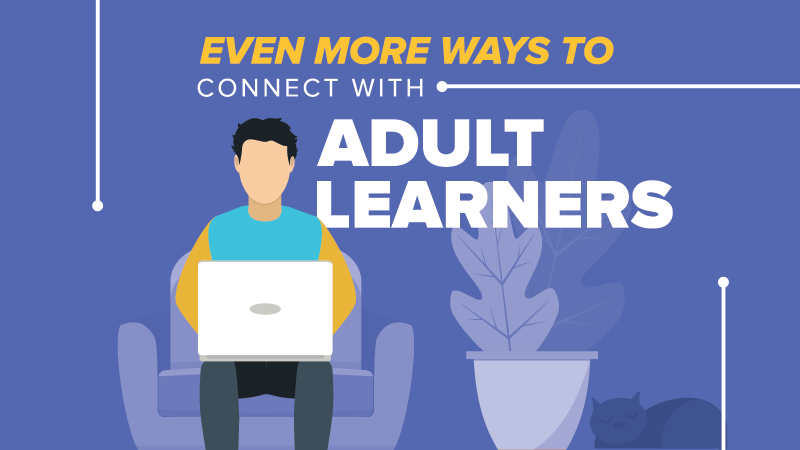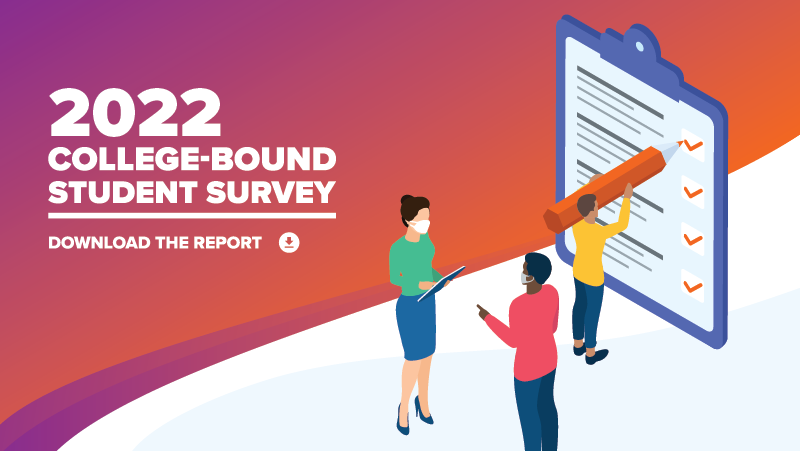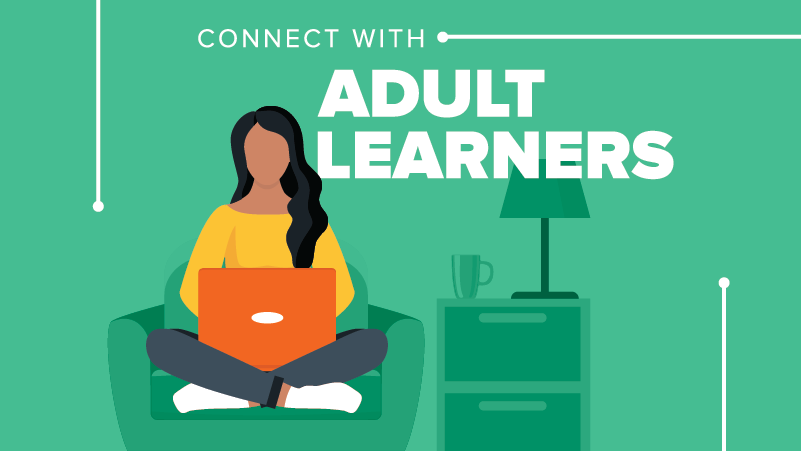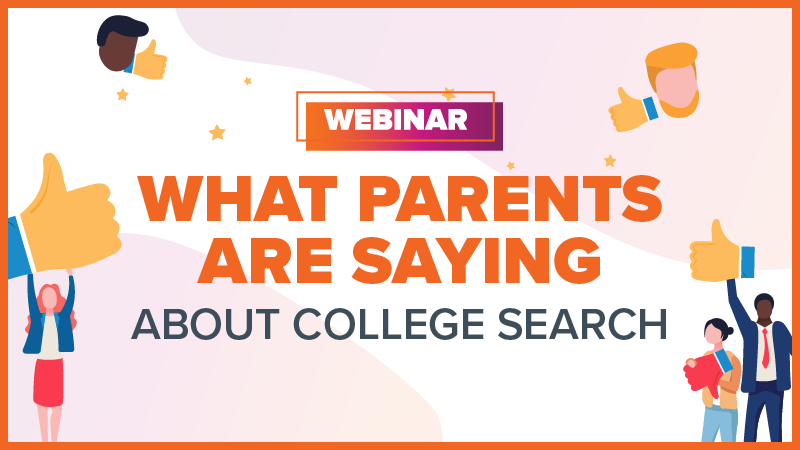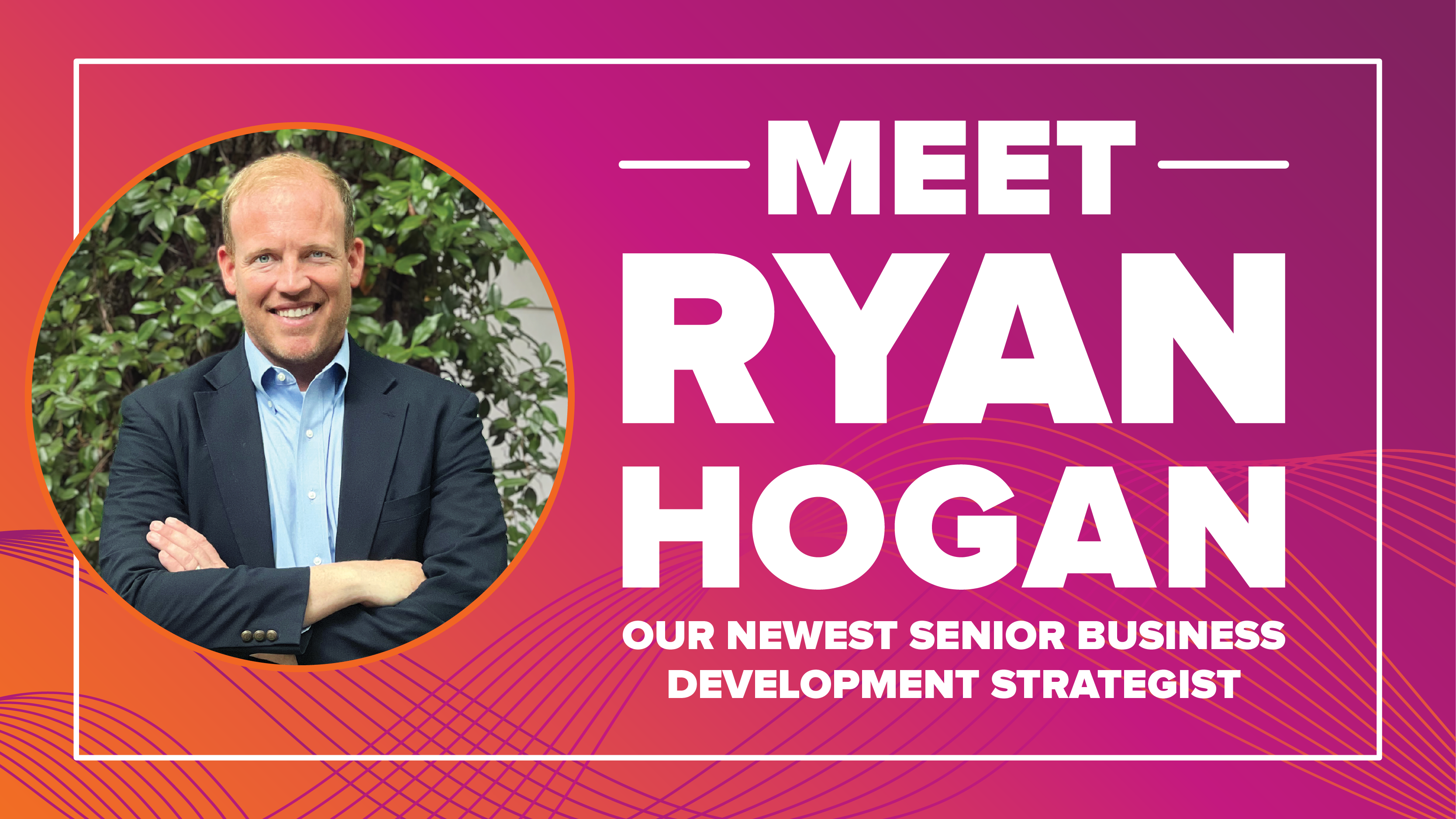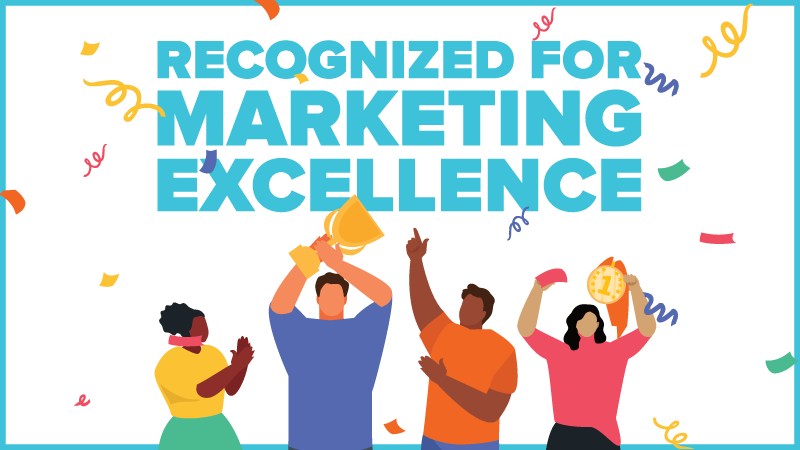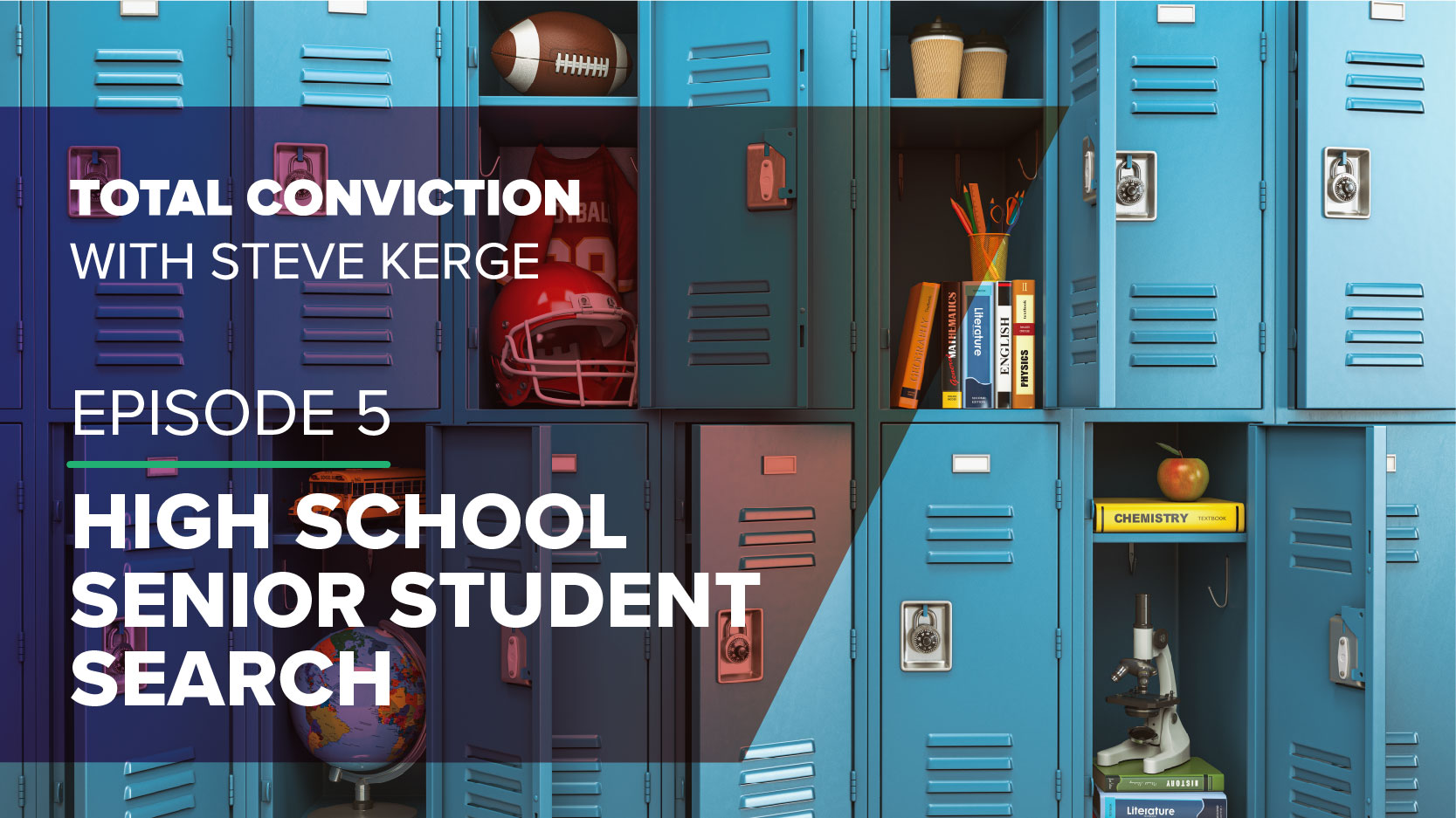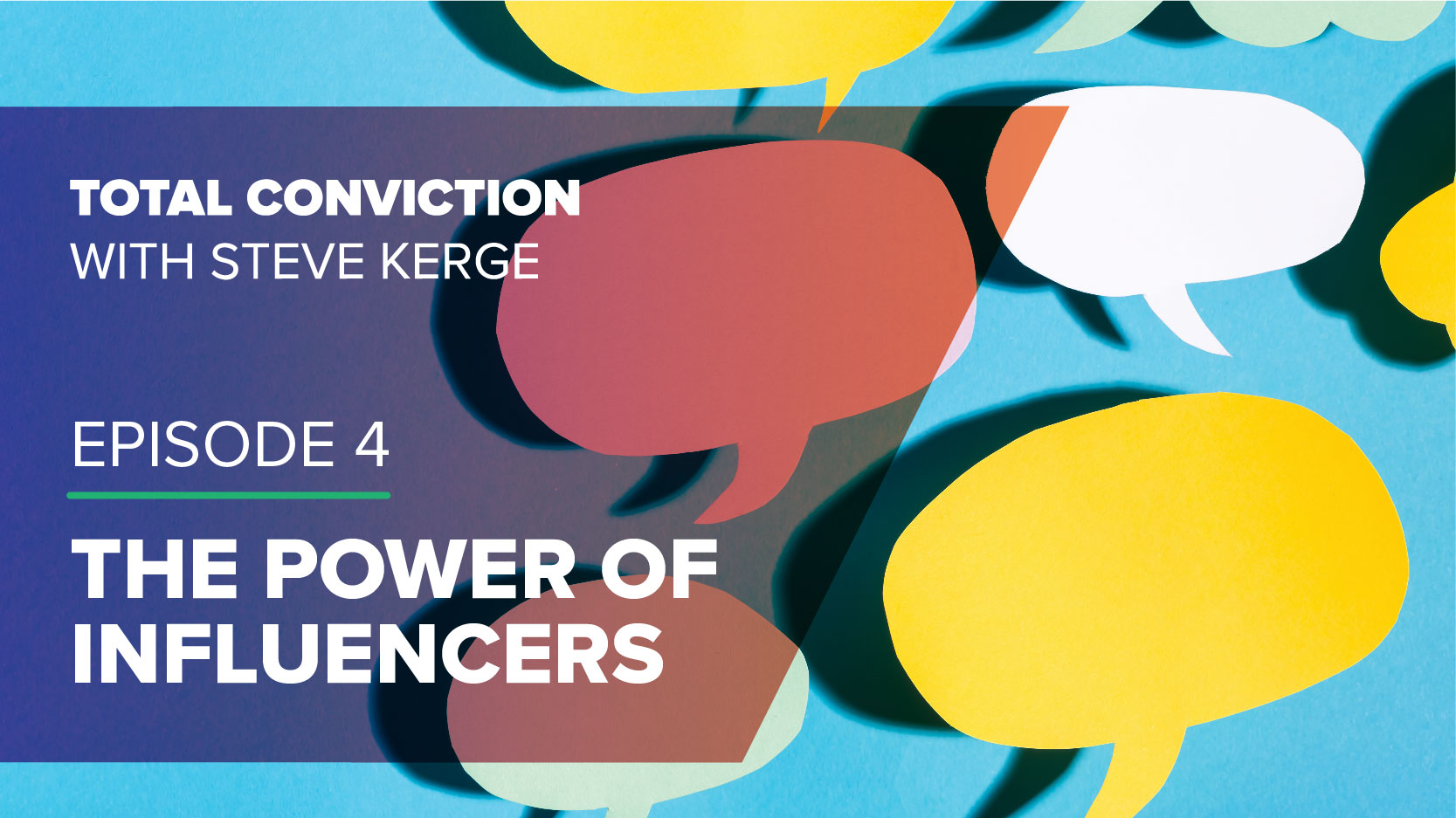Strategies to Increase Enrollment With Adult Learners: Part 2
Strategies to Increase Enrollment With Adult Learners: Part 2
The second installment of our two-part series
Welcome back to the second part of our series on enrollment strategies for increasing your adult learner population. In my last blog, I discussed how adult learners may be able to give institutions a much-needed boost to their enrollment by offsetting the decline of traditional-age students. I also shared two strategies on how to lay the foundation for attracting the right adult learner. In this blog, I go further into how you can engage with the adult learner as an individual.

"I was profoundly grateful to have my past work recognized by the educational institution I had chosen, and it absolutely motivated me as I navigated the ups and downs of going back to school mid-career, changing careers."
- Patricia Nagy-Travieso, current adult learner
Strategy 3: Recognize Life Experiences
Barriers to Enrolling
The idea of going back to school has been in adult learners’ minds for quite some time, but as more time passes, more obstacles appear. Lack of time, cost to attend, and fear of academic preparedness are major obstacles adults face when considering returning to, or beginning, college. Identifying the value of their life experiences and addressing their obstacles can help adult learners take the initial steps to enroll. Getting adults to recognize their own experiences — and value — will help them overcome their perceived inadequacies.
Value to Classroom
Dr. Charles Backes, a former colleague of mine with more than 30 years in adult and career education says, “Having adults in my courses changes the entire course along with the way that I teach it. In a traditional, child-centered setting, content is delivered in such a way that the young learner can put it away to be used at a much later time. For adults, particularly those who are in the workforce, application can be immediate. In fact, adult learners prefer to be able to conceptualize and apply information right away to tasks and situations that are current and possibly problematic. When I can provide specific examples of content application and tie it to something they have experienced, it brings the content of the course to life and makes it relevant. It can also lead to meaningful discussions for the whole class, whereby much of the course content may be actually delivered by the students themselves under the direction of the instructor.”
Life experiences help with learning and processing information, especially when earning a degree. Think about how the classroom and learning experience will change with adult learners in attendance — what value they bring and the positive impact on traditional students.
Prior Learning Credits
Adult learners’ life experiences have tremendous value and are an opportunity to attract them to earn a degree. For example, Patricia Nagy-Travieso is a psychology major, returning to college after working 20 years as a writer for ELLE magazine. The institution she attends gave her credit for required English courses after reviewing her portfolio and evaluating her work experience. Trish said, “It felt both incredible and humbling for me to get credit for my work at ELLE magazine, where I had spent over two decades of what would become the first half of my professional career. I perceived it as a recognition for my years-long experience in branding, media management, and content creation, and it ultimately had a concrete impact on my future education as I embarked on returning to school to pursue a completely new professional path in psychology. I was profoundly grateful to have my past work recognized by the educational institution I had chosen, and it absolutely motivated me as I navigated the ups and downs of going back to school mid-career, changing careers. The credits for my portfolio were a supporting and motivational validation in a professional decision that is not always easy to make, and helped to make the pieces fall into place. I now have a year left before I graduate with a BS in psychology, and I couldn’t be more excited about my studies, and my future.”
Creating a clear process for evaluating and providing academic credit based on life experiences not only provides a strong message to adult learners that those experiences have value and are appreciated by your institution, but also makes it that much faster and financially possible to start or complete their degree.
Strategy 4: Effective Communication
Once you have identified who your adult learners are, the programs they are interested in and the way they like to receive communications, your job is done, right? Hardly.
Communicating with adult learners is critical as an enrollment strategy and where the rubber meets the road. Institutions should review the entire communication journey for adult learners — from website and application to emails and events, and reflect on whether the language being used is appropriate for this audience. In a nutshell, you should speak to adult learners differently than you would speak to traditional-age students because they have vastly different experiences and perspectives.
Using the right words, in the right channels, at the right time is critical, but it also requires significant time, resources, and energy to craft, execute, and monitor your campaign’s progress.
Although there will always be challenges in higher education, this is an unprecedented time because there are just so many factors that have many institutions scrambling to address their declining enrollment with declining resources.
Don’t worry, though, you’re not alone. Spark451’s experienced strategy team has the resources to help institutions like yours identify potential adult learners and to craft a sound plan to help usher them through the enrollment funnel.
To discuss your institutions’ strategy to enroll adult learners, and Spark451’s innovative solutions and proven results with adult learners, please reach out.
2022 College-Bound Student Survey: Download The Report
Blog
Hear what 4,000 recent high school grads are saying about their college search process.
You already know that the college admissions world has been working through some unique challenges during the last few years, but you’ll probably still be surprised by some of the findings from Spark451’s latest College-Bound Student Survey.
This summer, thousands of 2022 high school graduates responded to the Spark451 Education Research Division’s 11th annual survey on the college selection process. Download the full report to gain access to all the valuable information for college admissions professionals, including:
- The Class of 2026’s social media habits
- Students’ reactions to test-optional admissions policies
- The effect of fee waivers on application decisions
- How students feel about text messages from schools
- So much more
Download the report now. Then, reach out. We’ll be happy to help you determine if your upcoming admissions marketing and student search plans are fully in line with the latest data from students.
Strategies to Increase Enrollment With Adult Learners: Part 1
Strategies to Increase Enrollment With Adult Learners: Part 1
Adult learners may be the answer to certain enrollment challenges
Across the globe, industries have experienced unexpected challenges due to the COVID-19
pandemic, and higher education is no different. Burnout, gaps in staff, lack of accessibility to resources, and changes in mental well-being have impacted us all. During the past two years, and especially more recently, colleges have faced additional hurdles to enrollment — declining freshman classes, attrition of faculty/staff, and reduction in resources. With the onslaught of challenges and more uncertainty ahead, leveraging adult learners can give institutions a much-needed boost to their enrollment.
Colleges are seeing a decrease in traditional (under the age of 25) students. According to the National Student Clearinghouse Research Center’s (NSCRC) June 2022 Undergraduate Degree Earners Report, traditional-age students decreased by approximately 25,000 students from the 2019–2020 school year, falling by 0.5%. Instead of enrolling in college right away, many high school graduates are opting to enter the workforce, where they can earn higher wages than companies were paying pre-COVID.
The challenges don’t stop there. Institutions across the country are experiencing the pressure to hit increasing enrollment goals with decreasing resources. Also, fear of a recession has some families rethinking the financial obligation that college requires. Plus, for the last several years, those in enrollment management have been preparing for the looming “enrollment cliff” coming in 2025 due to low birth rates during the 2008 recession, which will result in a prominent decrease in the college-aged population.
All of this paints a bleak picture for college enrollment. However, as with any challenge, there are some opportunities. Specifically, NSCRC’s June 2022 report shows an increase of 1.4% in the population of adult learners. Adults returning to college to hone their crafts, advance in their careers, or prepare for a shift in their careers is a chance for colleges to diversify their college classes, while filling in the enrollment gaps.
Here, I’ll share some ideas to help you reach and connect with adult audiences. Since this is a big topic, I broke this blog into two parts. Read my first two strategies in this post, and then, come back next week when my other two strategies will be released.
2020-21 Graduate Profile (N=3.7M)
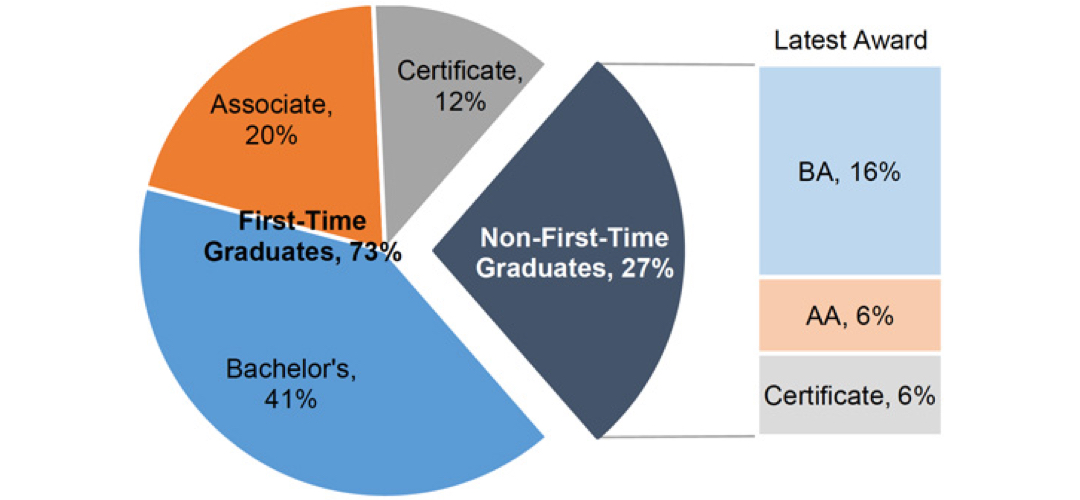
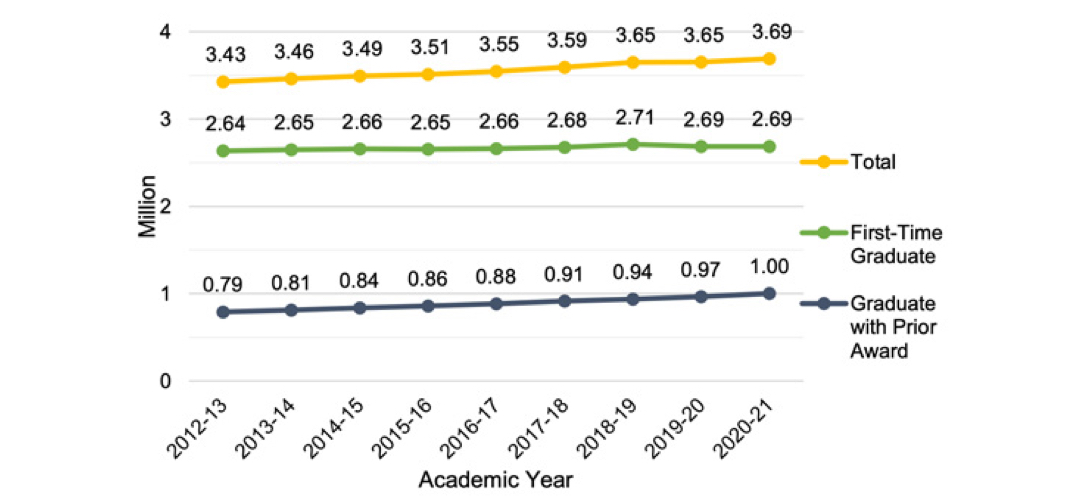
Strategy 1: Evaluate Academic Programs
In-Demand Programs
Evaluating and optimizing academic programs to evolve with demand and interest is a critical first step. According to NSCRC, the number of students earning baccalaureate– and associate-level degrees increased by 0.7% and 0.3%, respectively during the 2020–21 academic year. That 0.3% increase in associate level degrees is important, as the previous year saw a 3.7% decline. Take a look at your institution’s offerings, and consider if there are any additional degree programs you may be able to add to meet the changing needs of adult learners.
Modality
Another aspect of a college’s academic program to evaluate is the way the courses are offered. Although a majority of students prefer to have access to some fully online instruction (according to a Digital Learning Pulse Survey, 73% somewhat or strongly agreed that they would like to take some fully online courses in the future) many still prefer in-person learning. Asynchronous courses, meaning the student can access the course content on his or her schedule, are attractive to students who have full-time jobs or are located in other time zones, increasing your pool of potential students.
Strategy 2: Identify Your Population
Digital Strategy
Unlike traditional students, adults aren’t sitting in a high school classroom most of the day, but rather working, traveling to their kids’ practices, participating in committees, and taking care of their families. Identifying the right adult learners for your institution, based on your programs and course modality, takes creativity and strategy. Developing an adult learner marketing strategy that is too broad is a common mistake, resulting in a lukewarm outcome.
Instead, be more specific in your approach to identify and reach the best students for your institution with the best message. For example, using digital media ads that speak directly to that person about the program he/she is interested in will have better results than a general campaign with broad messaging hoping to reach all potential adult learners. You can support these campaigns with personalized microsites or program-specific landing pages that will use targeted messaging that will resonate with each particular audience.
Re-Engage Stop-Outs
The pandemic has impacted the number of students completing their degrees, with many leaving college just short. A recent Gallup-Lumina Foundation survey revealed that 85% of students who left college during the pandemic have considered re-enrolling. Reasons for leaving include decrease in finances, stress, academic concerns, and work obligations. Crafting strategies to address these specific concerns may be the key to getting these students to return to your institution.
Corporate Partners
Many companies offer tuition reimbursement or incentive programs to encourage their employees to obtain a degree. Identifying and forming partnerships with companies can benefit all parties — helping employers attract and retain employees and helping your institution reach its enrollment goals.
Enrolling adult learners is complex, but the ideas shared above should help you start crafting the enrollment strategy you need to be successful. Be on the lookout for my final two strategies in a blog that will be posted in the coming weeks. In the meantime, please feel free to reach out to schedule time to discuss tactics for your institution’s enrollment needs. At Spark451, we can help identify data points, such as socio-economic status, job searches in the college’s area, and other key indicators to help ensure your institution has the programs to attract adult learners and in the modality they prefer, and we can help you identify the right tactics for reaching those prospective students. We’d love to discuss your institution’s specific enrollment challenges and help you develop a plan to fill those gaps.
Parents Reflect on College Search
As a new academic year approaches and the next senior search season begins in earnest, now is the time to get your finger on the pulse of what matters most to your student’s biggest influencers — their parents. To help make it easier, Spark451 Research recently conducted an expansive survey of parents of Fall 2022 college freshmen.
In our recent webinar, enrollment strategy expert Pete Colbert released the findings of the 2021–2022 College-Bound Survey: Parent Edition, which features feedback from nearly 1,500 parents from 38 states. Some of the results will be eye-opening for even the most seasoned enrollment managers!
Watch the recording to gain insights about:
- Which communication tactics resonate best among parents
- Which application incentives resonate best among parents
- Whether most parents would encourage a child to transfer if they received a better offer from a competing school
- The timing of the college search process and when parents helped their children commit to schools
You’ll also have the opportunity to download the full report!
The Ultimate Balancing Act
The Ultimate Balancing Act
Managing Enrollment Demands When Staffing Resources Are Low
Over the past two years, higher education institutions have experienced turnover at an alarming rate. The Chronicle of Higher Education found that U.S. colleges and universities have shed more than 650,000 employees since the pandemic started. And the U.S. Department of Labor has not seen such a rapid decline in academic employment since it began keeping industry records in the late 1950s.
One of the most trusted and frequently used higher education job search engines, HigherEdJobs.com, lists over 4,500 available positions within admissions, enrollment management, and marketing across the country. These positions range from Vice President of Enrollment Management and Director of Marketing and Communications to CRM Specialist and Admissions Counselor. In fact, when surveying 20 random colleges and universities around the nation, we found there were 192 open positions. That’s an average of 10 per school in admissions, enrollment management, or marketing alone.
While the darkest times of the pandemic seem to be behind us and colleges have welcomed students back to campus, many schools are still feeling the hardships of the past two years. As an admissions team, you have adapted to communicate, think, and work differently. However, you’re also being asked to do a lot more with less, and you may not have the bandwidth to keep admission and enrollment projects moving along, the manpower to stay ahead of higher education technology that is ever changing, and continue to be innovative and competitive.
Let’s see how this translates into realistic situations.
Scenario 1: Reduction in Admission Counselor Staff
The pandemic has shown us that we can work from (almost) anywhere. Many dedicated admission counselors have had a taste of what a more flexible schedule feels like and have decided to leave their positions for employment elsewhere.
Scenario 2: Operations Staff and/or CRM Specialists Decide to Leave
You have innovative, data-oriented, results-driven operations staff and/or CRM specialists who maintain the flow of the application process and are the backbone of your student information system and data, but they’ve decided to move on in their careers.
Scenario 3: Decreased Marketing Staff
Maintaining a strong relationship between your marketing department and admissions team is vital for a continued stream of qualified students to be attracted and recruited for enrollment. It may not be only your admissions office that’s seeing a decline in staffing, but your marketing department could be losing valuable members, as well.
Solutions to consider:
- Utilize Your Internal Resources: Offer internship or employment opportunities to reliable students seeking experience in higher education admissions, marketing, or data analysis and information technology.
- Expand the Role of Your Student Ambassadors: Hire reliable student ambassadors to complete admission tasks such as phone and email follow up, and scheduling appointments for counselors. This can free up your admission staff to be more available for travel, connecting with prospective students, and application review and decision-making.
- Employ a Higher Ed Marketing Partner: Allocate unused budgets toward allowing a higher education marketing agency to take on admission and marketing projects for you. In my role as a Marketing Strategist, I partner with a diverse mix of colleges and universities, working with them on an ongoing basis to discuss unique strategies and tactics to improve their enrollments. I know that the leaders at these schools value the fact that I am there as a partner to focus on opportunities and ensure campaigns are running effectively.
It’s refreshing to see smiling faces on campus, open house events running again, and a more vibrant energy among faculty and staff. So, while certain difficulties of the past two years remain, there are effective solutions available to keep recruitment competitive, admission projects and systems running, and budgets under control.
To discuss your unique situation and the pain points you’re currently facing, please reach out to us. Our experienced strategy team would love the opportunity to bring innovative solutions to the table and develop a strategic plan to help shape your next fall class.
About Spark451
The higher education marketing experts at Spark451 truly understand the pain points you’re currently facing and will bring innovative and creative solutions to each project. Senior search, sophomore/junior search, admitted yield, E-communication plan workflows, graduate enrollment marketing, digital media campaigns, and customized CRM support are just a few of the tailored services Spark451 offers its clients. We’d love to brainstorm your unique situation with you and develop a strategic plan to help shape your next fall class. Connect with Spark451 today.
Perception Equals Reality: A Case Study on Price Point and Institutional Reputation
Last year, the Spark451 team partnered with Feedback to conduct a case study of a private college in New York City. We evaluated the college’s reputation, its competitiveness in the market, and its comparative price point to both peer and aspirational competitors to determine if they could afford a cost increase. We shared our findings in a recent webinar.
A recorded version of the webinar is now available. To access it, simply complete this form and we’ll send you a link to the recording right away! You’ll also be able to download the presentation deck.
During the session, Spark451 Senior Business Development Strategist Pete Colbert and Feedback Chief Behavioral Officer Dean Browell, Ph.D. discussed:
- why we conducted our study of a private college in NYC.
- the unique methodology and analytic approach used to assess market reputation competitiveness as a tool to determine the viability of price adjustments.
- the detailed results of our case study.
- the benefits of conducting the same research for your institution.
- candid thoughts on the efficacy of evaluating reputation to determine price adjustments.
Valdosta State University’s Ryan Hogan Joins Spark451
Valdosta State University’s Ryan Hogan Joins Spark451
Meet Our Latest Senior Business Development Strategist
Westbury, NY — Spark451, a Jenzabar company, is proud to welcome Ryan Hogan, our newest Senior Business Development Strategist. Based in Southern Georgia, Hogan will work closely with the company’s partner institutions primarily in the Southeast to help them achieve their enrollment goals.
“Ryan is well-known throughout the higher education community, and he brings a great deal of valuable experience to this role,” says Steve Kerge, Vice President of Business Development, Spark451. “I’m very enthusiastic about the insights and support he will be able to deliver to our partner colleges and universities.”
Hogan has spent 22 years in admissions and marketing at Valdosta State University. He fell in love with higher ed when he started working as an orientation leader during his freshman year at the university. He has since spent the entirety of his professional career climbing the ranks of the admissions office from recruiter, to associate director, and ultimately, to Director of Undergraduate Admissions — a position he’s held since 2015.
Throughout his tenure with Valdosta State, Hogan has become an expert at developing enrollment strategies as well as designing and executing marketing plans for undergraduate students, graduate students, adult learners, transfer students, and other prospective student pools. Along the way, he’s had several major wins, including:
- Enrolling the institution’s largest undergraduate class in history for Fall 2020 — a 9% increase over the previous fall (and he pulled it off in spite of all COVID-19-related challenges)
- Developing and implementing the university’s graduate recruitment strategy from scratch
- Increasing the institution’s Hispanic student population through targeted marketing campaigns
- Helping the university launch an online college for career advancement
- Building relationships with employers who can provide tuition reimbursement for employees who head back to school
Hogan brings a strong understanding of multichannel marketing tactics. He believes in data- driven decision-making and knows the importance of personalized messaging. He also has vast experience with implementing and using a wide range of CRMs, including Slate. Hogan also holds both a B.BA in management and an M.Ed in educational leadership from Valdosta State University.
After two decades of working in-house at a university, Hogan is looking forward to joining the Spark451 team so he can help multiple institutions identify winning strategies and achieve their enrollment goals. “After all of my years working in higher education, I understand the enrollment pressures colleges are facing,” he says. “I am looking forward to getting to know other colleges’ needs, and through Spark451, becoming their partner for success.”
About Spark451
Spark451, a Jenzabar company, is a higher education enrollment strategy, technology, and marketing firm that combines creativity with powerful technology to achieve measurable results. With a mission to help colleges and students fuel their future, the firm integrates a multitude of communication channels and platforms for effective enrollment marketing, student search, creative services, and digital media. Since 2011, Spark451 has worked with over 200 colleges and universities nationwide. For more information, please visit spark451.com.
All That Glitters: Spark451 Earns 8 Gold Awards
WESTBURY, NEW YORK — Higher education marketing firm Spark451, a Jenzabar company, is proud to announce that several recent marketing projects — launched in cooperation with our valued college and university partners — have earned recognition from respected industry organizations. This year, the firm’s work earned eight gold awards, along with several silver, bronze, and merit awards.
“We take tremendous pride in knowing that our creative work is not just effective, but also inspiring,” says Irene Scala, AVP, Executive Creative Director. “And most importantly, the work is a result of a team effort — a deep collaboration with our partner institutions, who set the bar high, and our designers and writers, who rise to the challenge again and again.”
Here are our latest award-winning projects:
Collegiate Advertising Awards
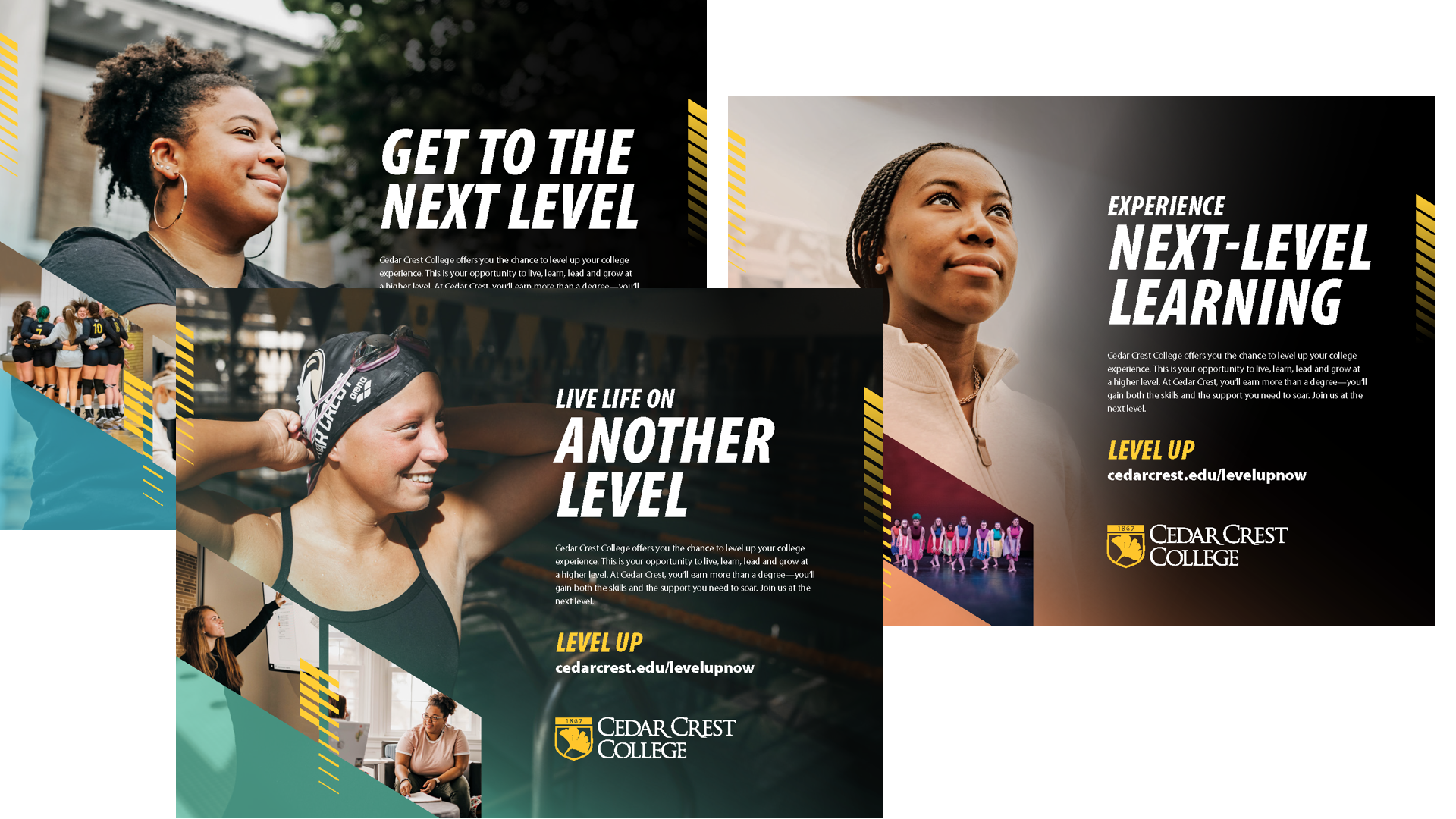
Cedar Crest College
Category: Poster/Display – Series (Silver)
Project: On-Campus Posters
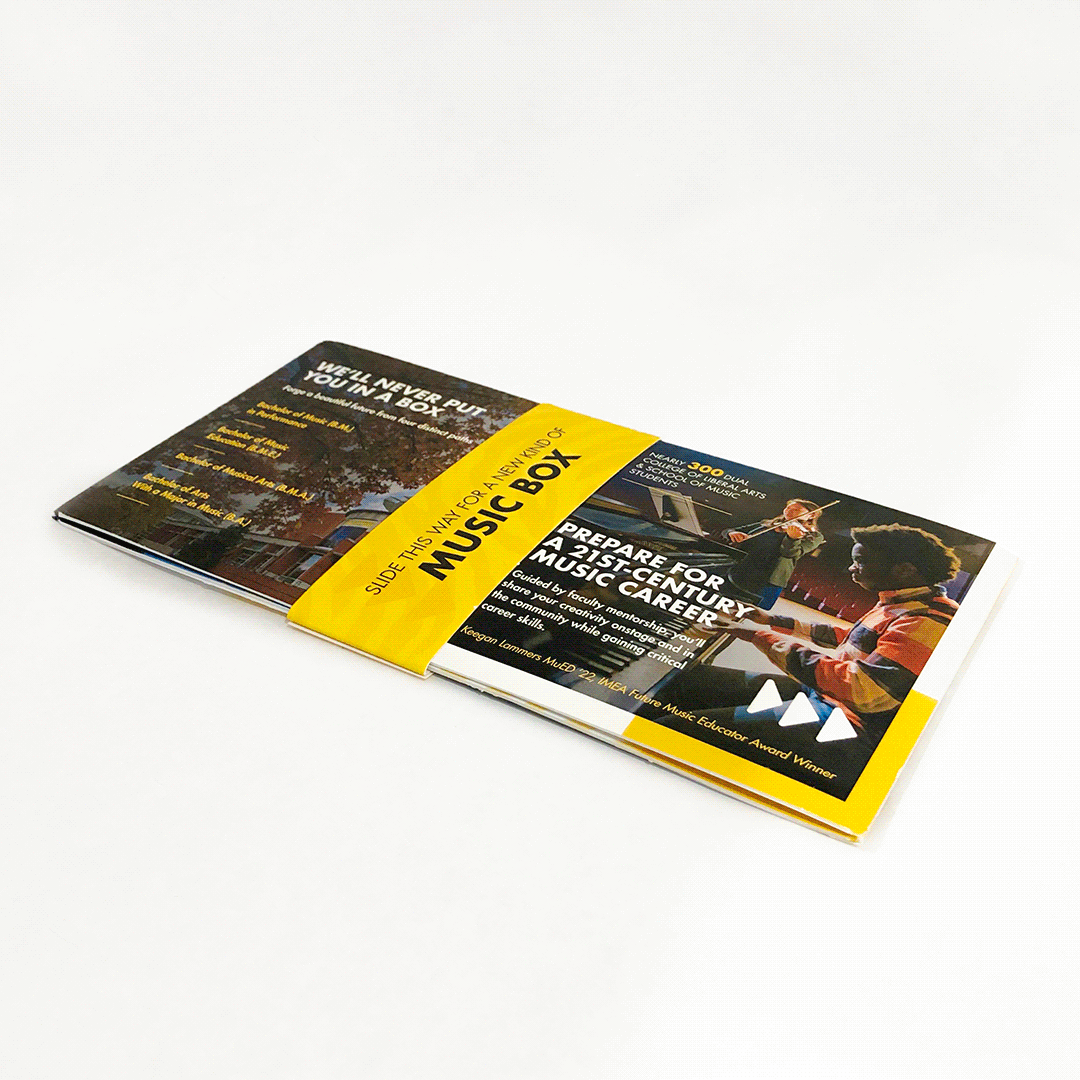
DePauw University
Category: Direct Mail – Single (Gold)
Project: Pop-Up Cube Mailer
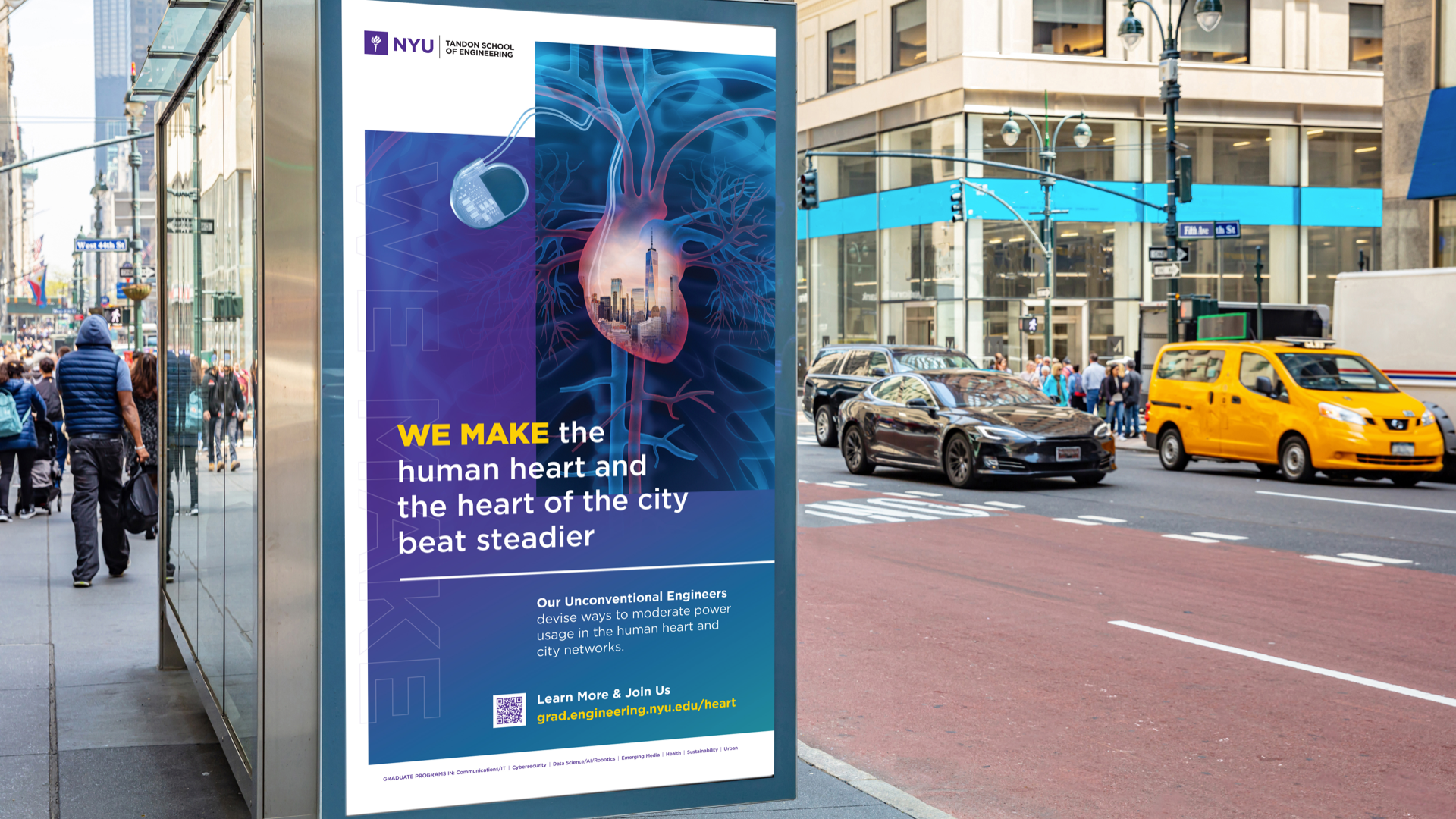
New York University Tandon School of Engineering
Category: Outdoor Transit/Airport/Subway – Series (Gold)
Project: Out-of-Home Breakthrough Campaign
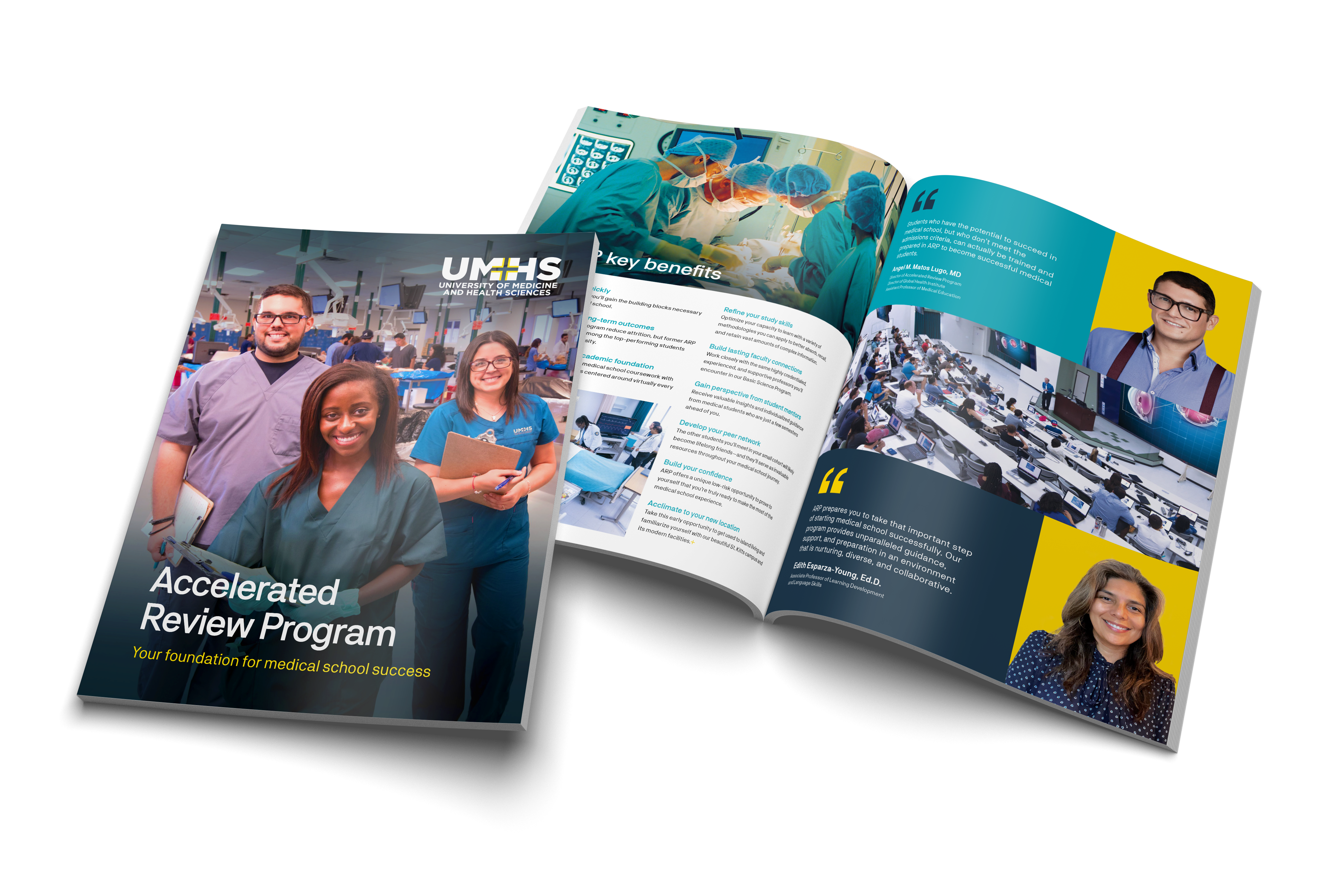
University of Medicine and Health Sciences
Category: Student Viewbook – Electronic (Silver)
Project: Accelerated Review Program Viewbook
Educational Advertising Awards

Cedar Crest College
Category: Brochure (Merit)
Project: Travel Brochure
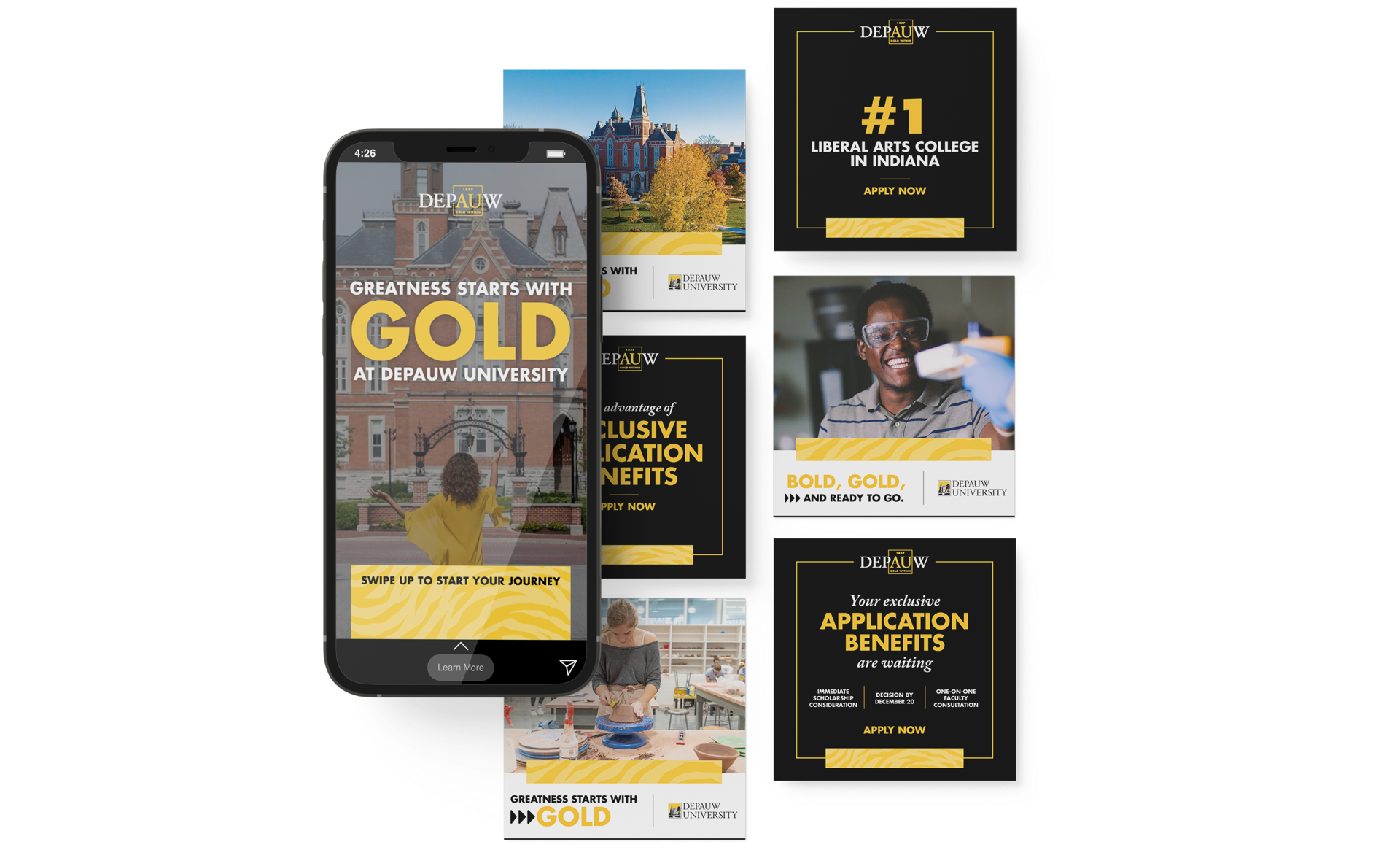
DePauw University
Category: Social Media Content (Silver)
Project: Senior Search Digital Media Campaign
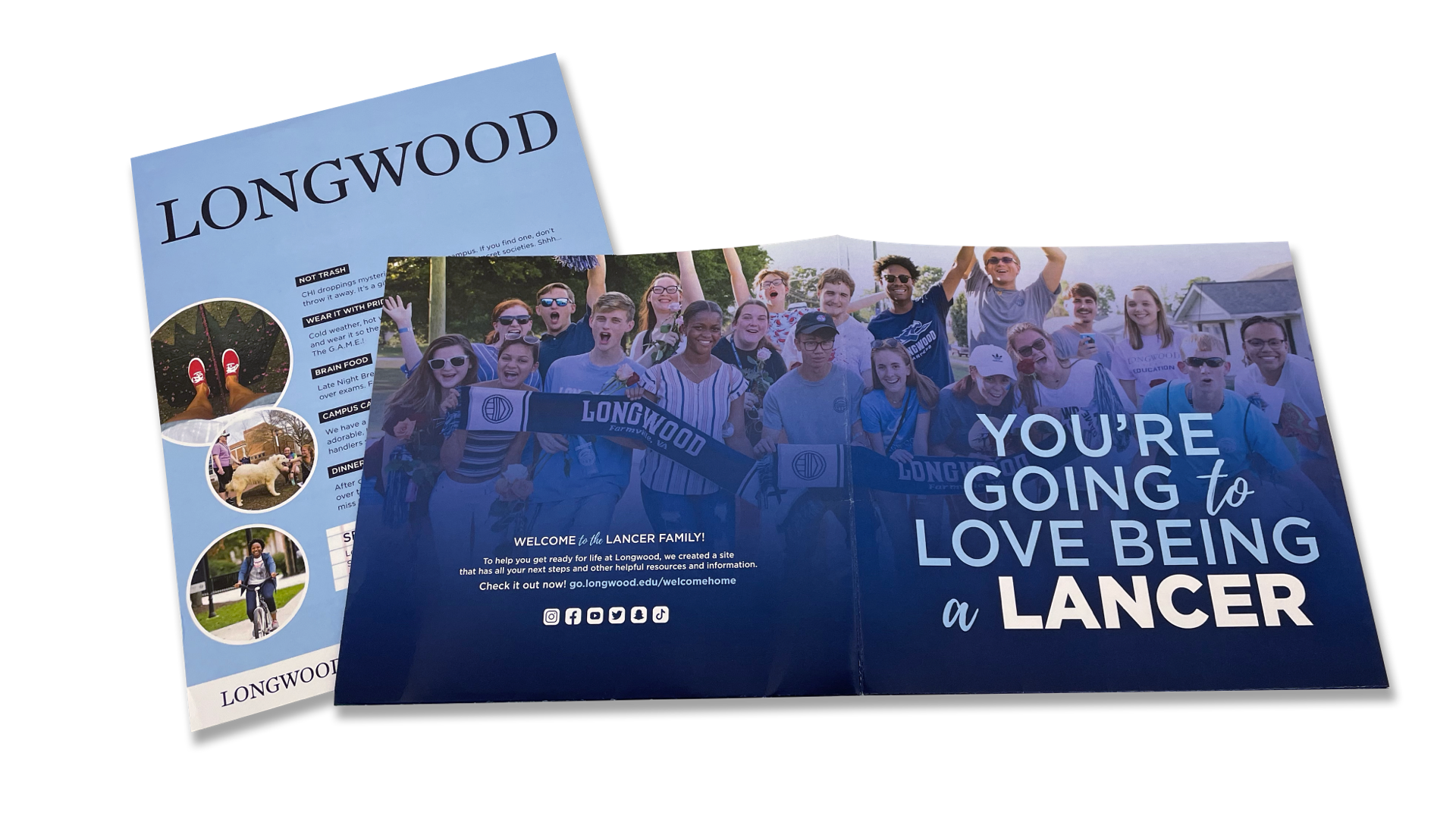
Longwood University
Category: Search Pieces (Gold)
Project: Admitted Student Packet

Longwood University
Category: Direct Mail (Merit)
Project: Search Postcard Series
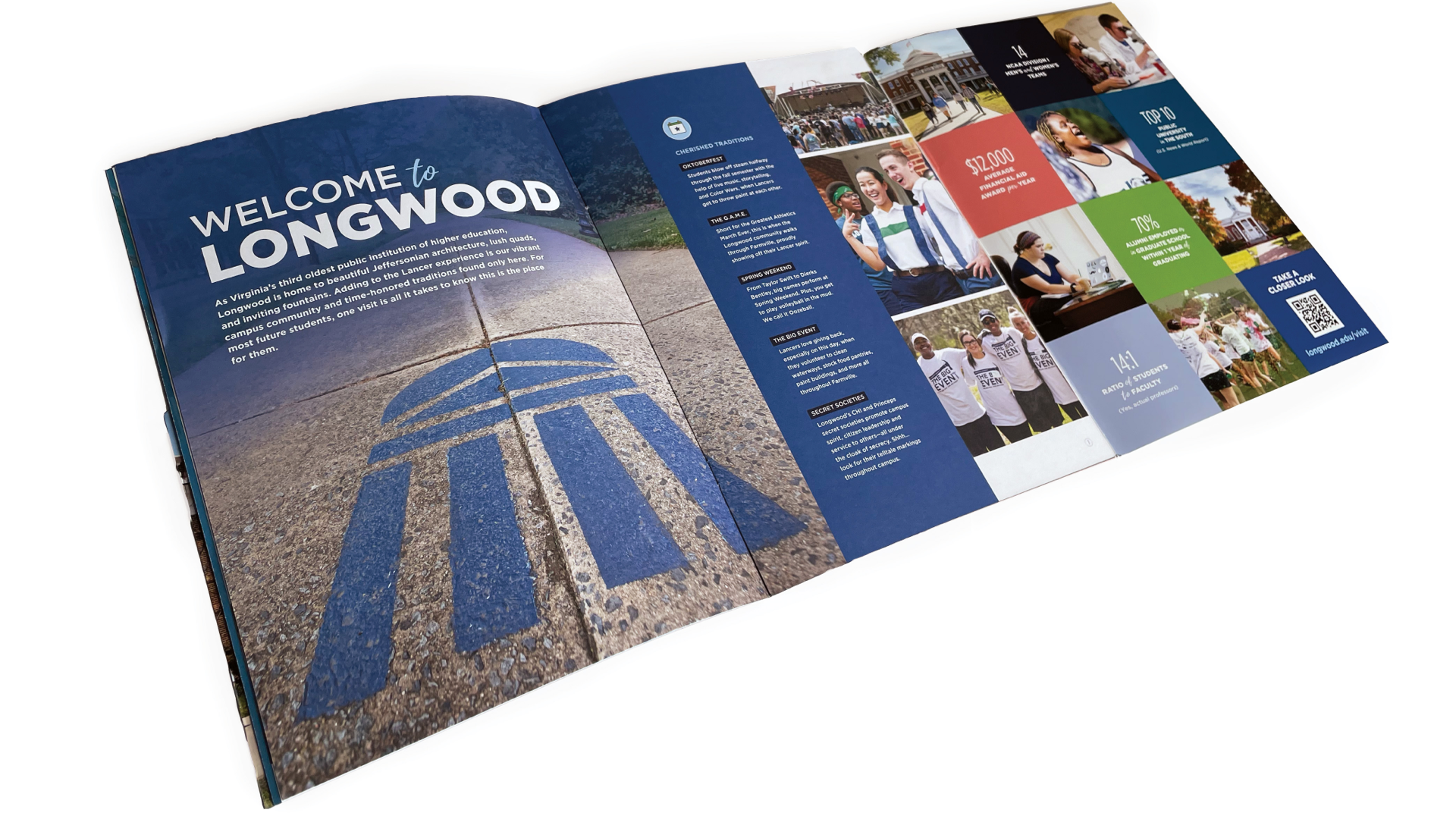
Longwood University
Category: Student Viewbook (Merit)
Project: Student Viewbook
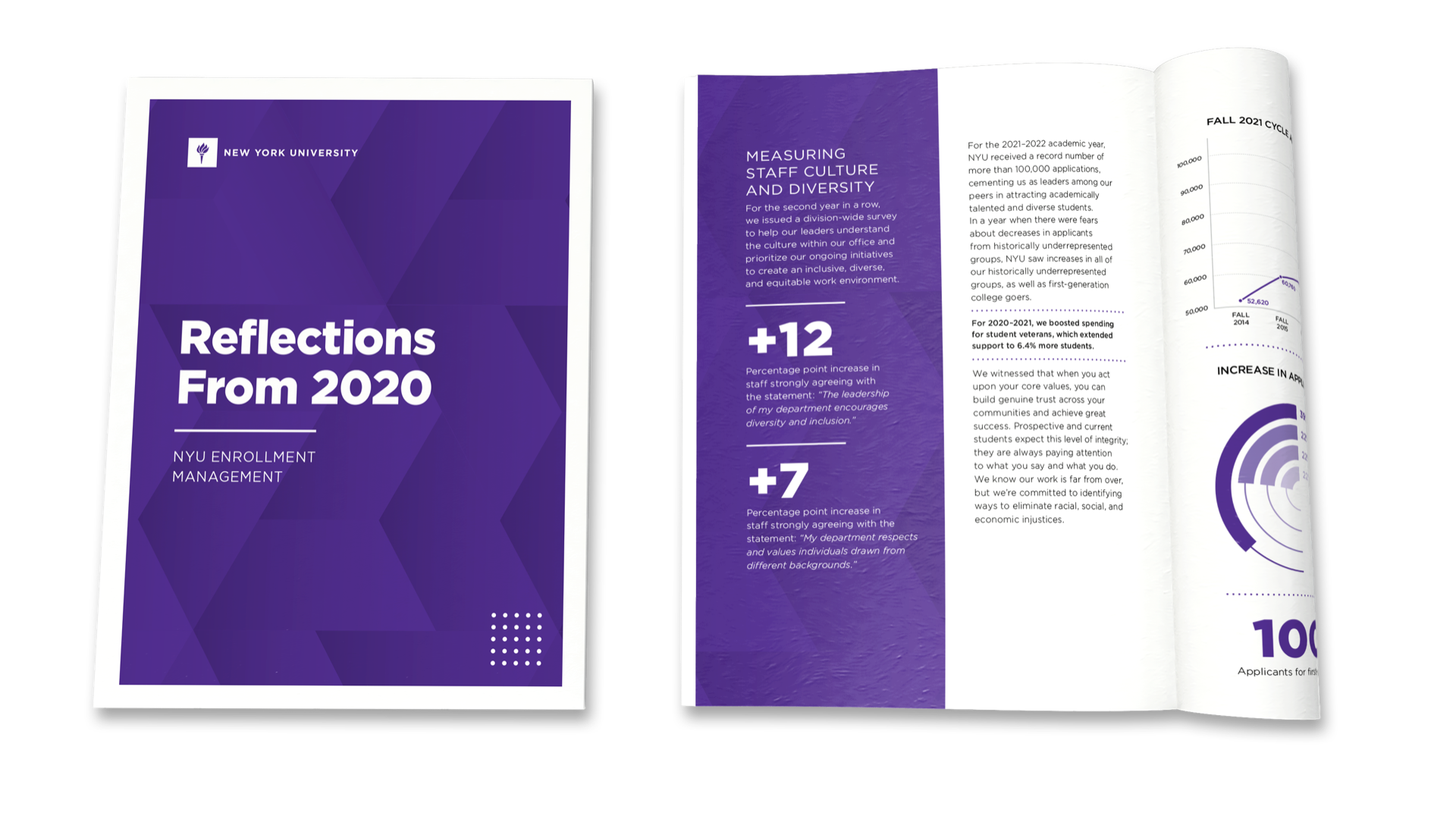
New York University
Category: Annual Report (Bronze)
Project: Reflections from 2020-Annual Report
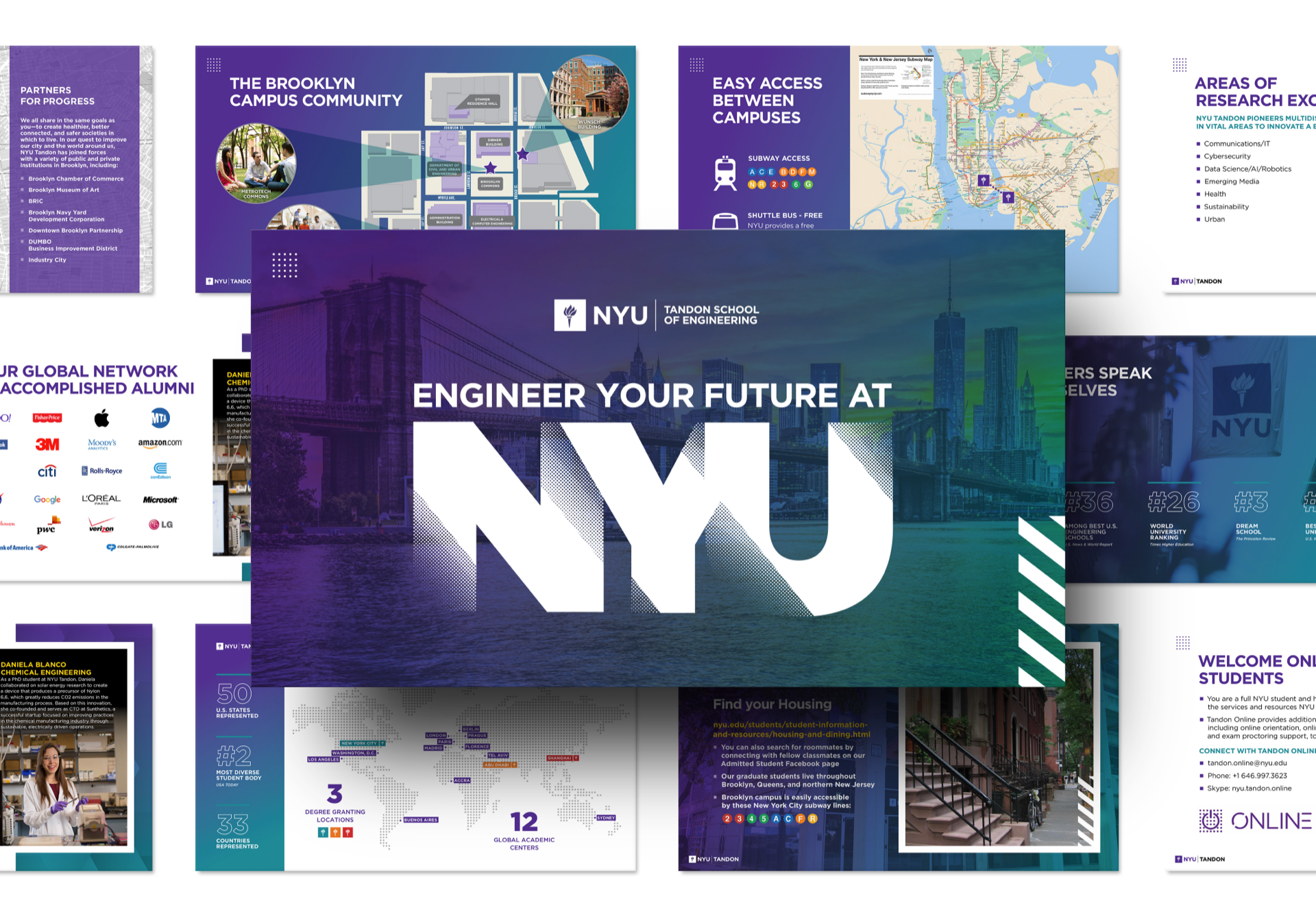
New York University Tandon School of Engineering
Category: Special Event Materials (Gold)
Project: Admitted Students Presentation
Education Digital Marketing Awards
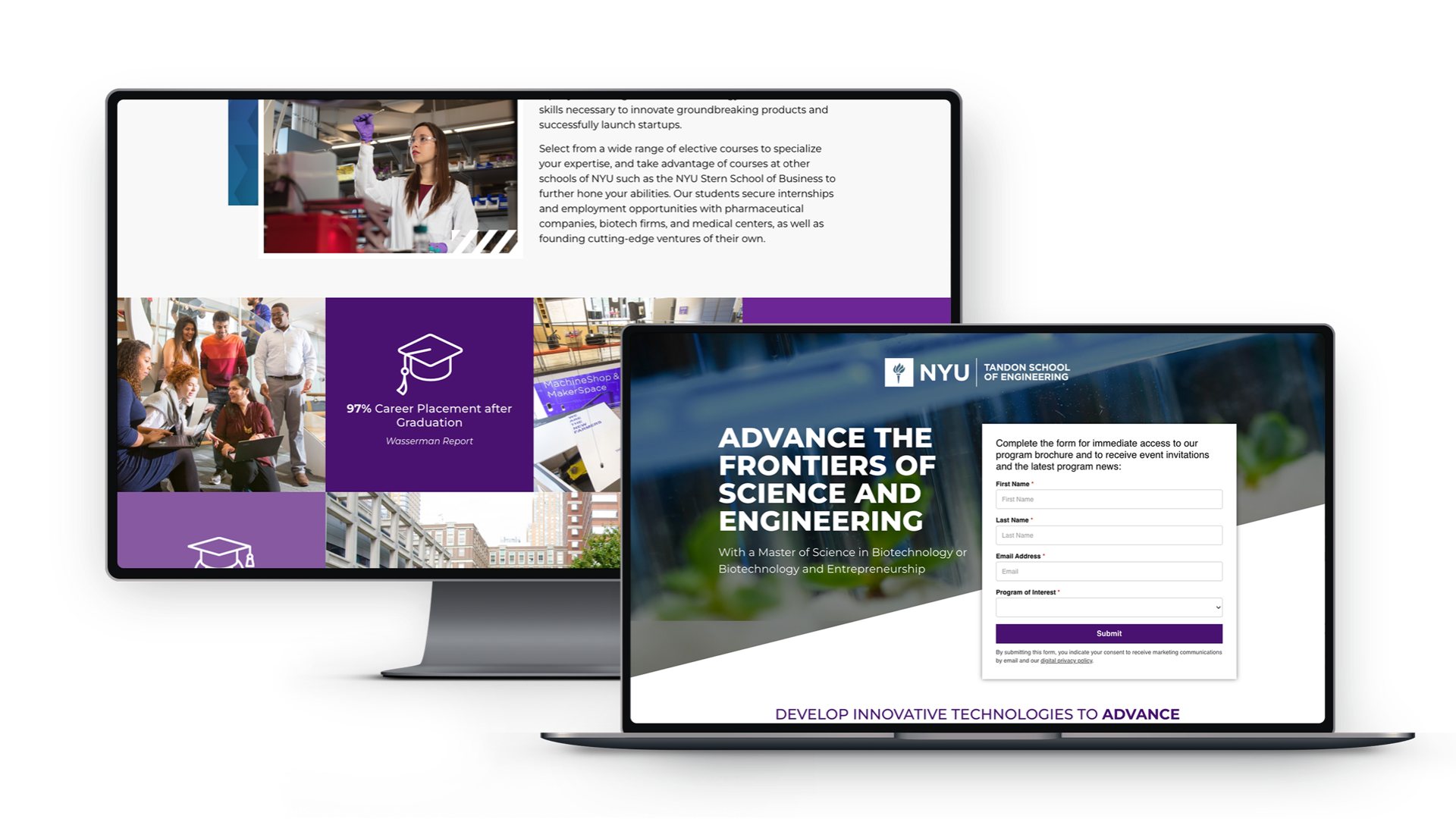
New York University Tandon School of Engineering
Category: Admissions Website or Microsite (Gold)
Project: Graduate Landing Page – BioTech Program

Longwood University
Category: Digital Video Ad (Bronze)
Project: Instagram Open House Ad
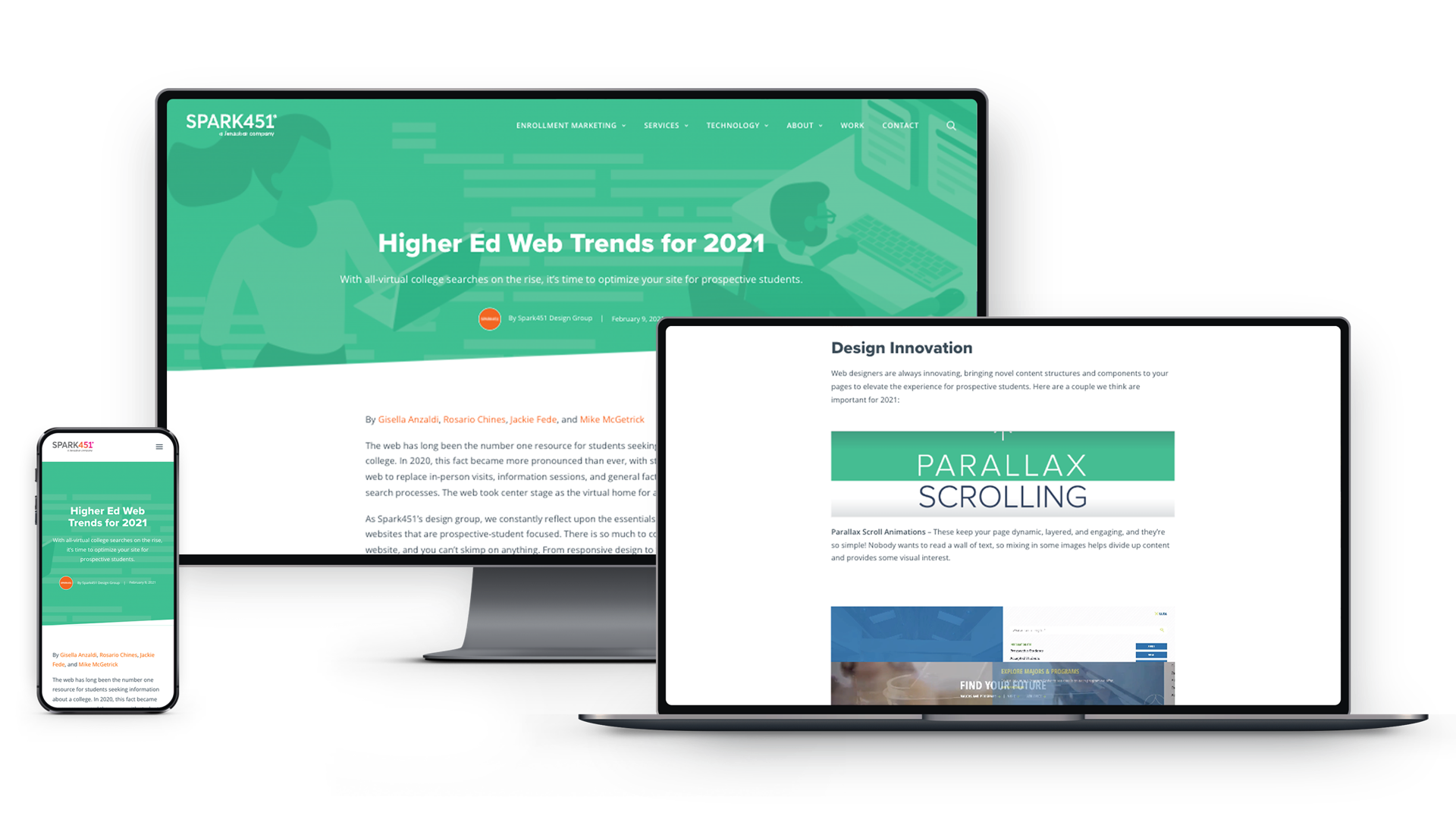
Spark451
Category: Blog (Gold)
Project: Web Trends Blog

Saint Louis University
Category: Digital Video Ad (Merit)
Project: EMIB Program
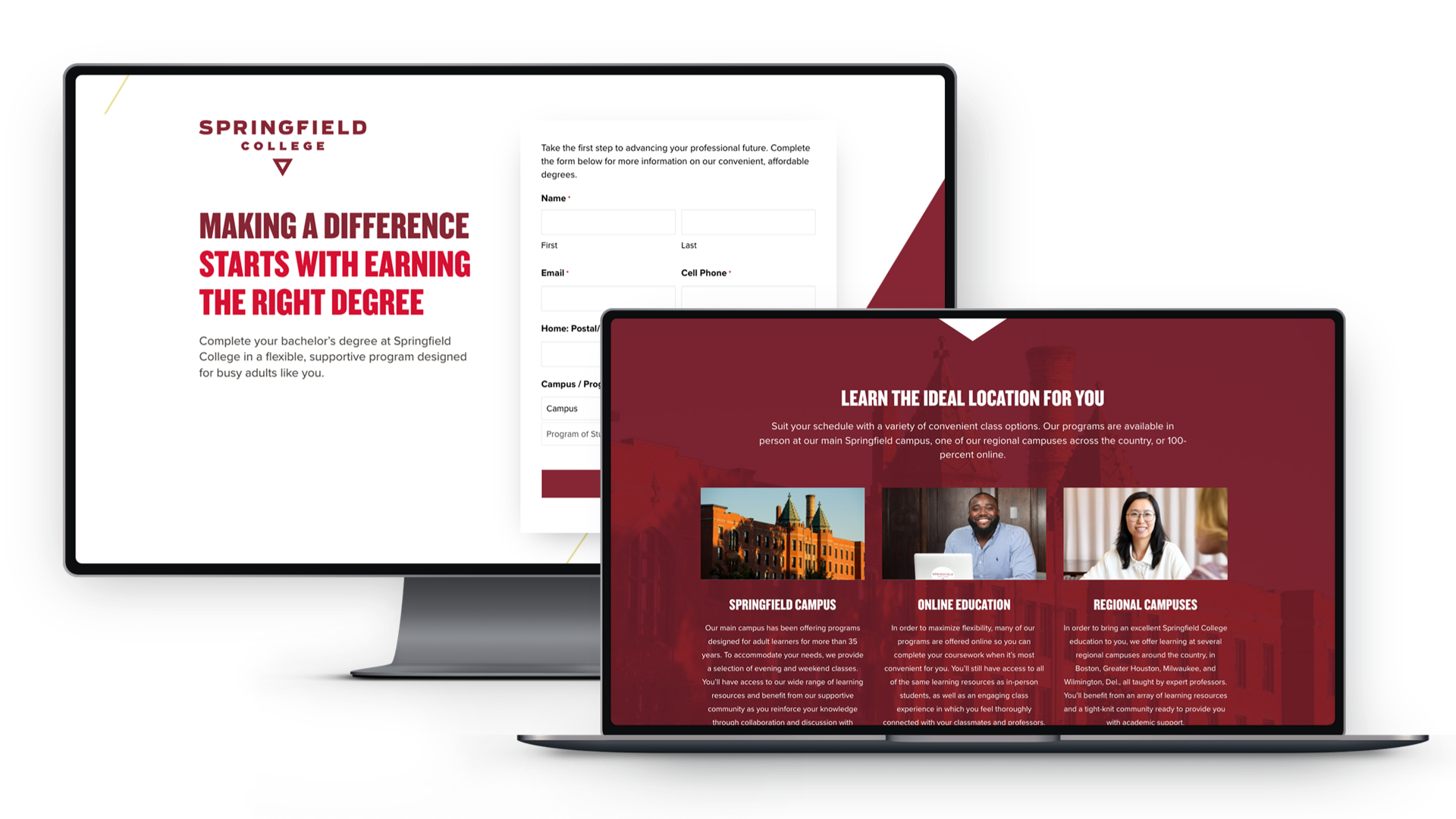
Springfield College
Category: Admissions Website or Microsite (Gold)
Project: Landing Page
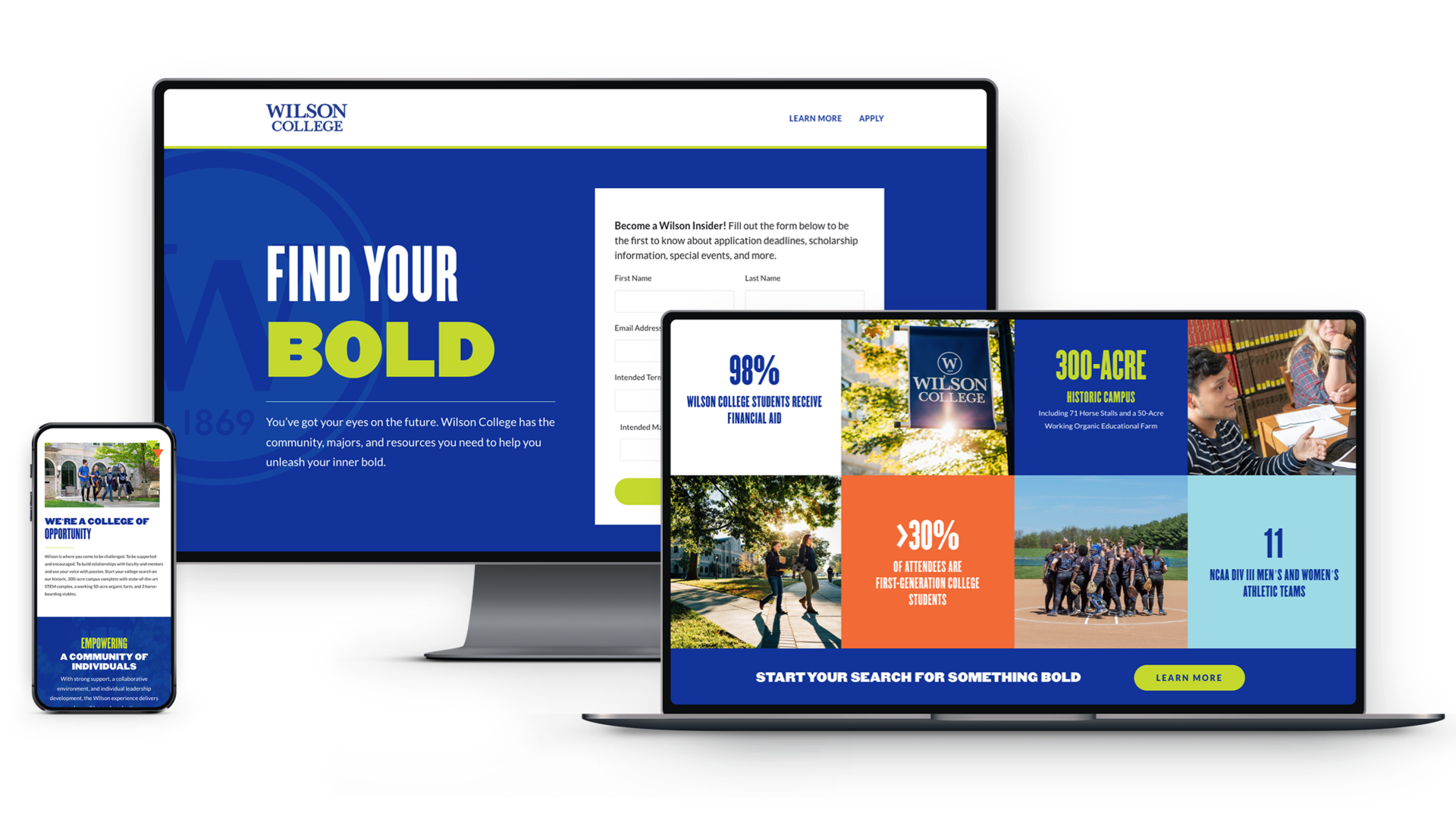
Wilson College
Category: Admissions Website or Microsite (Gold)
Project: Landing Page

Longwood University
Category: Digital Video Ad (Merit)
Project: Instagram & Snapchat Ad
To view even more of our work, check out our creative portfolio.
High School Senior Student Search
In the latest installment of our video series, “Total Conviction,” Spark451 CEO Steve Kerge explores why high school senior student search is more important than ever. He examines how the landscape has changed due to the effects of COVID-19 and its impact on student test-taking, and offers suggestions for improving your search techniques and increasing enrollment. Check it out above!
When you’re ready to discuss how to optimize your institution’s approach to student search, please reach out. Our experienced content strategists and enrollment marketing team will be happy to help you create a budget-friendly plan that will support your goals.
You can also revisit the full collection of “Total Conviction” videos here!
The Power of Influencers
In the latest installment of our video series, “Total Conviction,” Spark451 CEO Steve Kerge discusses the important role high school counselors play as influencers in the college search process. He explores the impact that this critical group of colleagues has on juniors and seniors as they consider their college options, and provides tips for strengthening your brand awareness among them. Check it out above!
When you’re ready to engage in a conversation about creating powerful influencer communication plans for your institution, please reach out. Our team of enrollment marketing experts and insightful content strategists will be happy to help you develop a budget-friendly plan that achieves your objectives.
You can also revisit the full collection of “Total Conviction” videos here!
